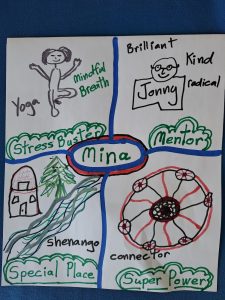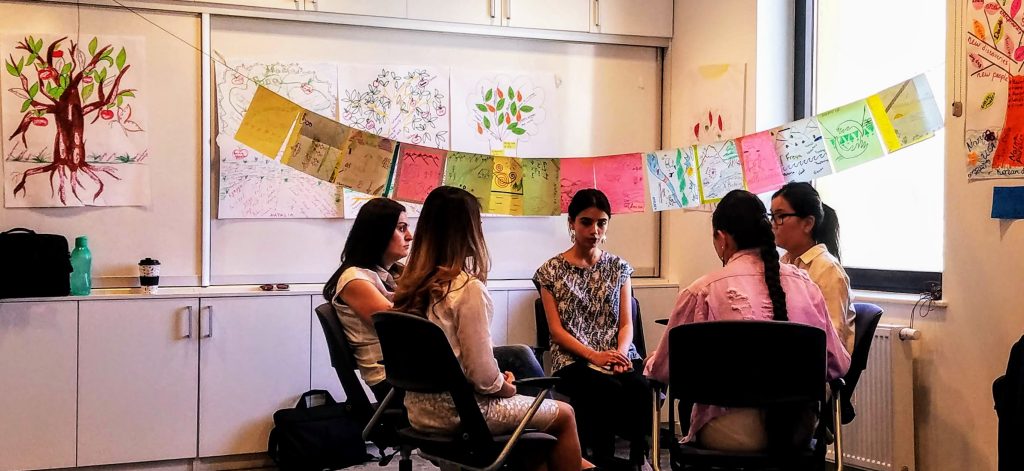12 Personal Flags
“Personal flags” is a learning activity borrowed from a Teaching Engish as a Second Language curriculum and it is designed to help learners practice talking about themselves and asking questions to get to know one another.
Purpose of the Activity:
While creating personal flags, participants reflect on aspects of their life that create their unique preferences, experiences and personality. The sharing of the flags gives a group an opportunity to deepen relationships.
Learning Objectives
Participants will:
- Reflect on parts of themselves that create their coping skills and identity.
- Share their flag with group members.
- Practice empathic listening and summarizing content.
- Practice asking questions that help someone to talk about their life.
Activity Directions
- Design demo flag ahead of time: Facilitator should design their own flag ahead of time or use the example below to have as an example to explain this activity.
- Full Group Discussion: Ask them about their country’s flag and what it symbolizes.
- Why do countries or organizations have flags or logos?
- How do you feel when you see your national flag or the flag of an organization you belong to?
- What do the colours and symbols on the flag mean to you?
- Why do nations or groups or tribes create symbols to show their identity?
- Explain Activity: Tell them that they are going to create a personal flag that symbolizes aspects of their life and what has shaped their identity. Show the flag you created ahead of time as a visual example.
- Distribute paper: Hand out 9″ by 13″ pieces of rectangular paper and ask them to fold down the top two inches of the paper so that they can be taped or stapled later to hang on a piece of yarn or string.
- Directions: Ask them to draw an oblong circle in the middle of the flag for their name and then divide the rest of their paper into four quadrants.
- Label the four quadrants with four aspects of their life that will engender rich reflection and discussion. For a new group, label with topics that help people to identify personal resources and strengths. In the example below, the quadrants are:
-
- Stress buster (what do you do to relax or deal with stess?)
- Mentor (who is someone you admire or who has helped you be the person you are?)
- Special Place (what is a place you love to hang out or that inspires you?)
- Super power (what is a personal strength or one of your unique gifts?)
-

7. Draw Flag: Allow group 15-20 minutes to create their flag. Reassure them that they do not have to worry about being a “good artist”. You could also make this more open ended and, instead of giving them categories, just ask them to create a flag that represents their identity.
8. Share: Participants share their flags. This can be done in many different ways. As an active ice-breaker the whole group can stand and mingle and meet someone and ask about one quadrant and then move on to someone else so that they meet many different people. For a more in-depth discussion, the group can be divided into dyads or triads to fully discuss these aspects of their lives. If it is a small group, it works to go around the circle and have each person share their flag.
9. Hang Flags: When the mingle or triad discussions are finished, tape or staple the back flap of the paper so you can hang them on a piece of yarn or string to create a paper version of prayer flags.
10. Full Group Discussion: If this activity is done as a Mingle or Triad discussion, it is worthwhile to bring the full group together again to process the experience. The following debriefing questions can extend that activity so that there is reflection on the process of self-disclosure and active listening.
Debriefing Questions:
- What was it like for you to reflect on these aspects that make you unique?
- What did you learn about someone else in this group that surprised or impressed you?
- How did you find the experience of talking about yourself and these elements of your life?
- When your partner was listening to you, what made them an effective listener?
- What kinds of questions can you ask to get to know someone better?
- When you look at all our flags hanging here together, what impressions do you have of us as a group?

Variation
A variation of this activity was done when a group member was in the hospital. Everyone created a prayer flag for the ill person and they were hung in the window of the hospital ward. Similarly, a group made prayer flags for a woman just before her pregnancy due date. She hung the prayer flags in the birthing room and they inspired her during labour.
Materials
- Printer paper
- Markers, pencil crayons (optional collage materials)
- tape or staples to make flap for string to pass through
- string, yarn or clothes line for display
Resource
